9 Best Native Plants for Grand Rapids, MI
BY LASHONDA TUCKER | APRIL 9TH, 2023 | GRAND RAPIDS, LANDSCAPING, MICHIGANFrom the Frederik Meijer Gardens to the Blandford Nature Center, Grand Rapids is home to many beautiful landscapes. It’s easy to appreciate the variety of colors, sizes, shapes, and fragrances of the plants. The good news is that you can create the same environment in your yard with the best native plants for Grand Rapids.
Once you open your yard to native plants, you and the ecosystem will experience a range of benefits:
- Native plants are adapted to the Grand Rapids climate, so they require less water and fertilizer.
- Native plants are less vulnerable to diseases and pests.
- Native plants provide food and habitats to pollinators and wildlife.
- Using fewer pesticides and fertilizers means fewer chemicals running off into the water supply.
Native plants offer a variety of choices. From native wildflowers to native shrubs to perennials with pretty white flowers, it won’t be hard to find native species that will thrive in your West Michigan home landscape.
This article will cover:
- 9 Native Plants for Your Grand Rapids Yard
- How to Choose Native Plants for Your Grand Rapids Landscape
- FAQ About Native Grand Rapids Plants
- Where to Find Native Plants in Grand Rapids
9 Native Plants for Your Grand Rapids Yard
1. Red-Osier Dogwood (Cornus sericea)
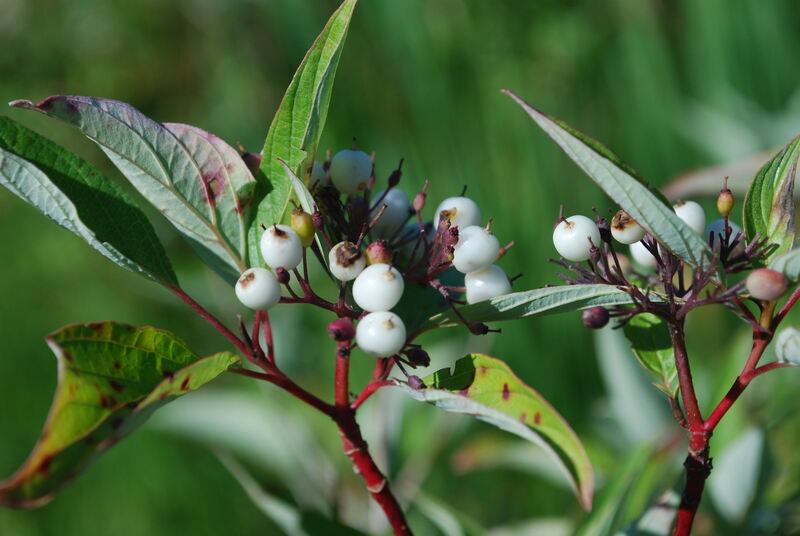
Photo Credit: Joshua Mayer / Flickr / CC BY-SA 2.0
Red-osier dogwood is also called red twig dogwood. No doubt named because it is red and looks like a small tree limb or twig. It blooms in spring and summer and adds a splash of color to the cold Grand Rapids winters. It’s a favorite because it develops its beautiful bright color, which is usually red, in the fall and winter.
It will be at home most anywhere, as it adapts to a wide range of soil types. If you’re looking to make a quick impression, you’ll appreciate how quickly this shrub grows. Red-osier dogwood is also functional; its roots help reduce erosion.
This shrub offers a beautiful cluster of creamy white flowers that appear in late spring to early summer. Pollinators and butterflies stop by to admire the small petals, while birds feast on the berries.
It requires full sun to partial shade, so a home with a few trees that allows in a moderate level of light will provide a warm welcome for the red-osier dogwood.
Plant type: Shrub
Hardiness zones: 2 to 7
Sun: Full sun to partial shade
Soil: Chalk, clay, loam, sand, moist, adaptable to a wide range of soils.
Duration: Perennial
Bloom time: Spring and summer
Water needs: Medium to high
Mature height: 6 to 9 feet
Maintenance: Medium. Use a spade to root prune if you want to stop it from vigorously spreading. Prune in early spring to encourage new stem growth.
2. Swamp Milkweed (Asclepias incarnate)
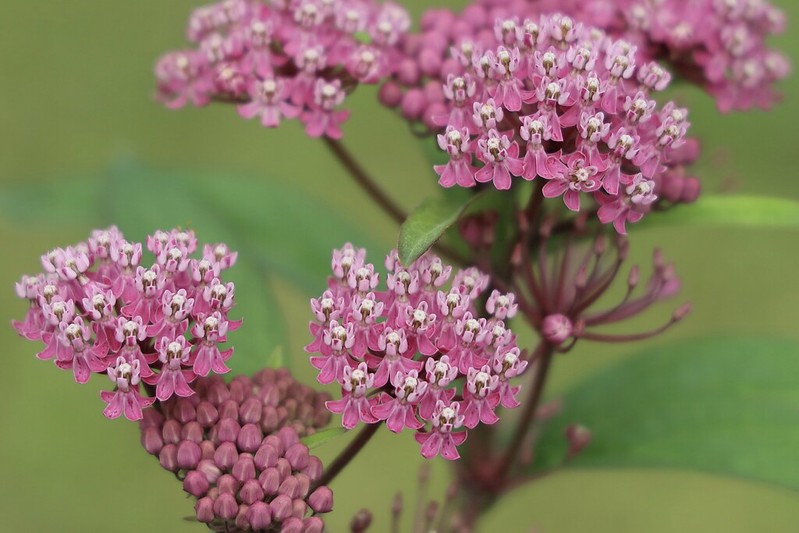
Photo Credit: Lydia Fravel / Flickr / CC BY 2.0
This beautiful cluster of tiny, hot pink petals sits atop stems with long, erect leaves emerging on opposite sides. Swamp milkweed is commonly found in the wetlands and blooms between June and October. It’s poisonous in large quantities, so be sure to keep small children from giving it a taste test.
Hummingbirds and butterflies are some of this flower’s biggest fans. Monarch butterflies depend on this perennial for survival. Swamp milkweed makes a great addition to rain gardens and butterfly gardens.
Even though swamp milkweed is usually found outlining ponds and streams, it adapts to drier conditions like loam and clay. The best home for this sappy weed is one that gets a lot of sunlight. The flower tolerates partial shade but thrives best when it can salute the sun.
Plant type: Flower
USDA Hardiness Zone: 3 to 9
Sun: Full sun to partial shade
Soil: Organically rich, slightly acidic, well-drained soil
Duration: Perennial
Fragrance: Sweet smelling
Bloom time: Midsummer to fall
Water needs: High
Mature height: 4 to 6 feet
Potential hazards: Poisonous to humans and animals in large quantities
Maintenance: Low
3. Nannyberry (Viburnum lentago)
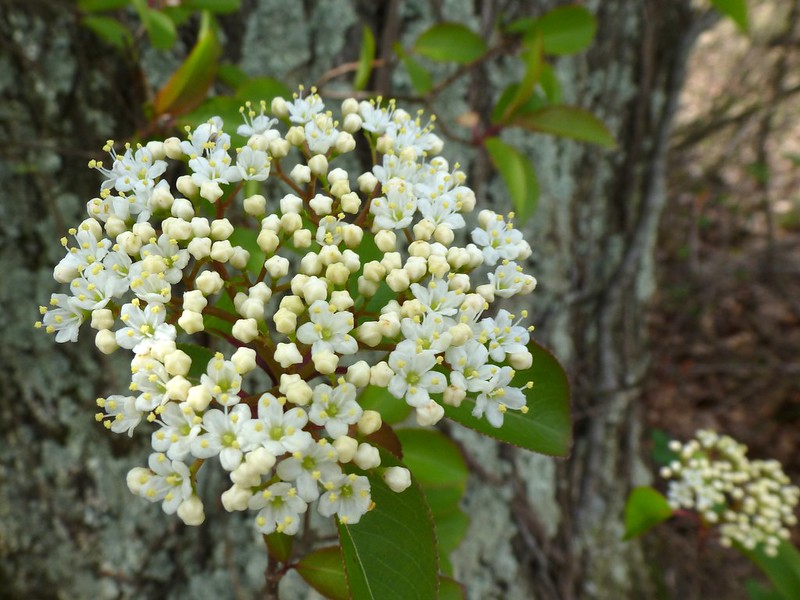
Photo Credit: Wendell Smith / Flickr / CC BY 2.0
This plant’s berries are enjoyed by wildlife, birds, and humans, too. That is, if you can reach the berries. Nannyberry is a very large, tall shrub or a small tree. This plant is a Grand Rapids favorite because its dark berries are usually still around in the winter, and the berries attract wildlife and birds, too. Nannyberry’s creamy white flowers sprout in the spring.
Nannyberry prefers full sun but will adjust to partial shade. If you have a shady yard, be on the lookout for mildew on your nannyberry. Other than that, it’s insect and disease tolerant. If you’re looking for a good, natural privacy screen, plant nannyberries as hedges. Nannyberry also works well as shrub borders and foundation plantings.
Plant type: Shrub or small tree
Hardiness zones: 2 to 8
Sun: Full sun to partial shade
Soil: Clay, loam, sand, moist, well-drained soil
Duration: Perennial
Bloom Time: May
Water needs: Medium
Mature height: 10 to 20 feet
Maintenance: Low. Prune immediately after flowering.
4. Butterfly Weed (Asclepias tuberosa)
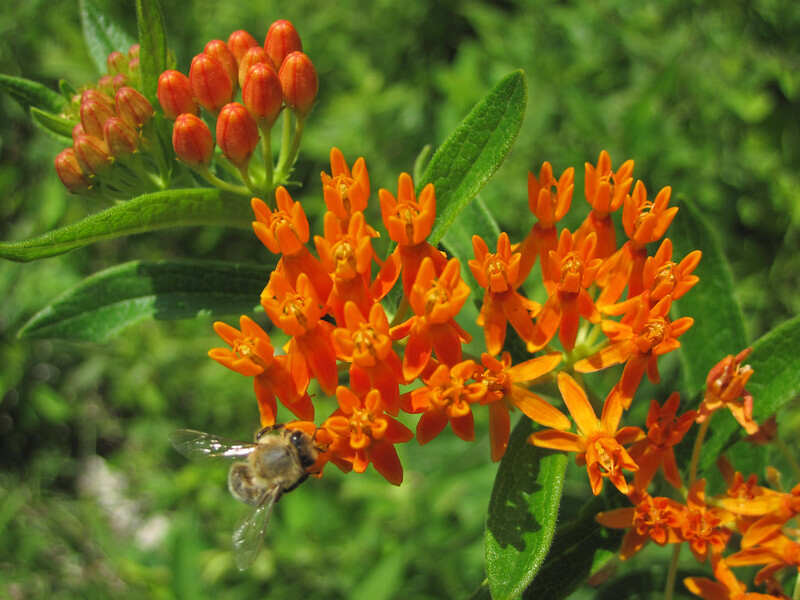
Photo Credit: James St. John / Flickr / CC BY 2.0
Butterfly weed’s yellow and orange petals are a wonderful site for sore eyes and for bees, butterflies, and hummingbirds. Grand Rapids homeowners can give back to the ecosystem by planting this bright plant, as monarch butterflies depend on it for their existence.
If you have poor soil, you’ll be happy to know butterfly weed isn’t picky. Although it prefers well-drained soils, it grows in dry, poor soils, too. This plant is drought-tolerant and easy to care for, but it may attract aphids. To get rid of aphids, hit the plants with a strong spray of water.
Like swamp milkweed, butterfly milkweed comes with some concerns. All parts of this perennial herb are considered poisonous. It can result in skin or eye irritation when touched. Be sure to handle this attractive plant with gloves, and plant it somewhere not easily accessible to pets and small children.
Plant type: Perennial herb
USDA Hardiness Zone: 3 to 9
Sun: Full sun to partial shade
Soil: Well-drained dry to mid-range soil moist. Loam, sand, or clay
Duration: Perennial
Fragrance: Sweet vanilla fragrance
Bloom time: May – September
Water needs: Low
Mature height: 2 to 3 feet
Potential hazards: Poisonous to humans and pets
Maintenance: Low
5. Black-Eyed Susan (Rudbeckia hirta)
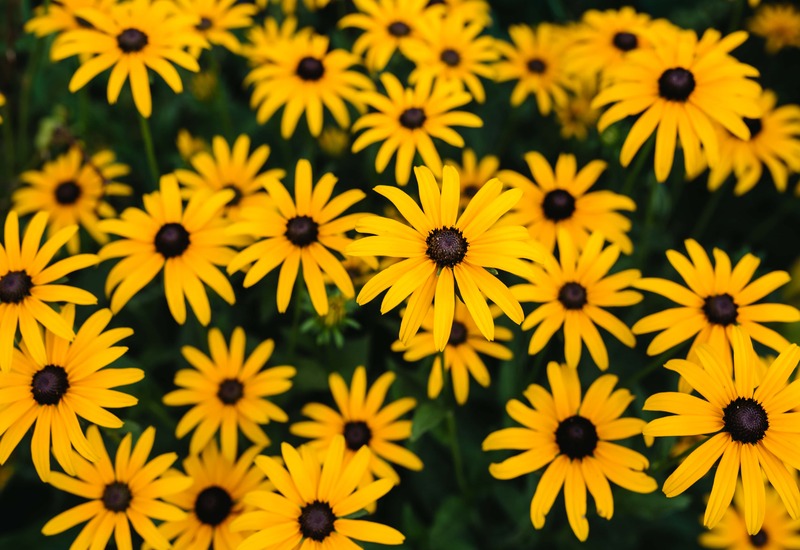
Photo Credit: Pixnio
Black-eyed Susan is appropriately named for its dark center and sunny disposition. With its long, yellow petals, it resembles a daisy. Young plants may attract snails and slugs, but other than that, black-eyed Susan has no major disease or pest problems. She was made for the Grand Rapids winters – young plants can withstand a little frost.
This daisy look-alike is easy to grow and works well in borders or as an accent plant. Butterflies, pollinators, and birds flock to this ray of sunshine.
Plant type: Flower
USDA Hardiness Zone: 3 to 9
Sun: Full sun. Can tolerate some partial shade
Soil: Dry, moist, well-drained soils.
Duration: Annual, Perennial, or Biennial depending on growing conditions
Fragrance: Sweet
Bloom time: Early summer to early fall (Jun – Sept)
Water needs: Medium
Mature height: 1 to 3 feet
Maintenance: Low. Black-eyed Susan requires about one inch of water weekly when first planted and is drought-resistant once established.
6. Virgin’s Bower (Clematis virginiana)
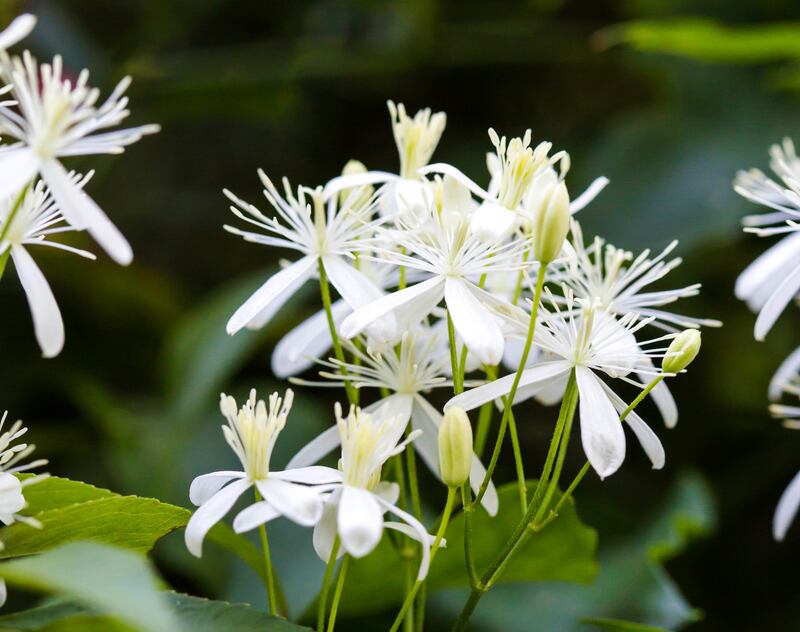
Photo Credit: Melissa McMasters / Flickr / CC BY 2.0
Virgin’s bower, also called the devil’s darning needles, is toxic to humans and pets. The strong bitter taste and mouth pain this vine causes humans when ingested is usually a quick and memorable warning that it’s not edible.
Virgin’s bower withstands occasional flooding and thrives best in soils that are rich and moist but well-drained. If you have a very shady yard and have been looking for a flowering vine that likes to climb high, look no further. Virgin Bower loves to wind around fences and up walls and trellises. If you’re looking for it to seed, be sure to get the female version. The male plant does not seed.
Just know that Virgin Bower likes to wrap around other plants and can invade the space of other vegetation, like shrubs. Pruning it in the spring can help manage its aggressive spread.
Plant type: Vine
USDA Hardiness Zone: 3 to 8
Sun: Partial sun
Soil: Organic-rich, well-drained loamy or silty soil
Duration: Perennial
Fragrance: Sweet smelling
Bloom time: July – September
Water needs: Medium to High
Mature height: 12 to 20 feet
Potential hazards: Poisonous to humans and animals
Maintenance: Medium
7. Little Bluestem (Schizachyrium scoparium)
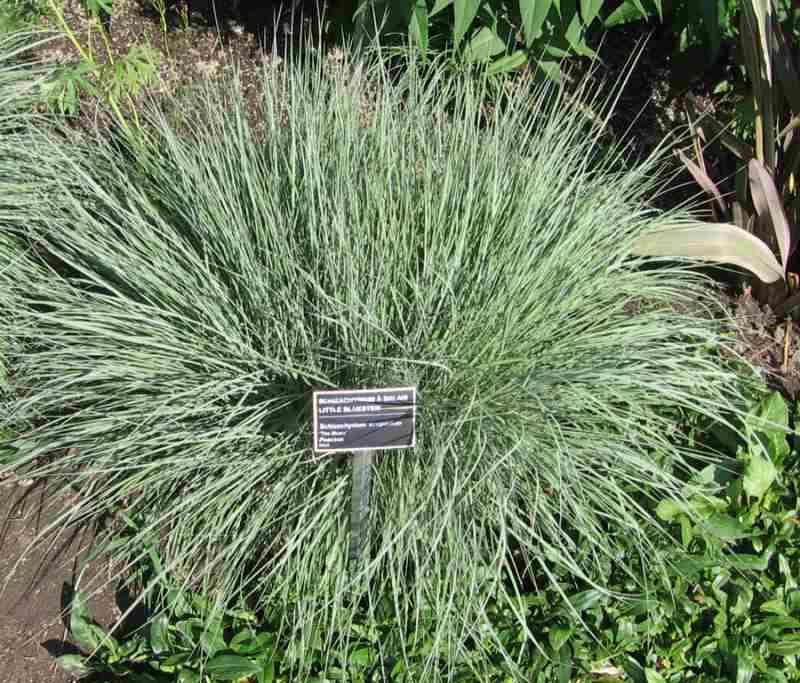
Photo Credit: Montrealais / Wikimedia Commons / CC BY 3.0
Little bluestem is not afraid to stick around through the harsh Grand Rapids winters. This ornamental grass provides cover for wildlife year-round. It has a blue-green color in the summer and a copper color that stands its ground through the winter. The leaves are yellow-orange in the fall.
It’s drought-resistant once established and works well in a xeriscape garden or rain garden. This year-round colorful grass is low-maintenance and shares its seeds with small mammals and songbirds.
Plant type: Ornamental grass
USDA Hardiness Zone: 3 to 9
Sun: Full sun
Soil: Dry to moist, well-drained soils
Duration: Perennial
Bloom time: August – February
Water needs: Low
Mature height: 2 to 4 feet
Maintenance: Low
8. Common Boneset (Eupatorium perfoliatum)
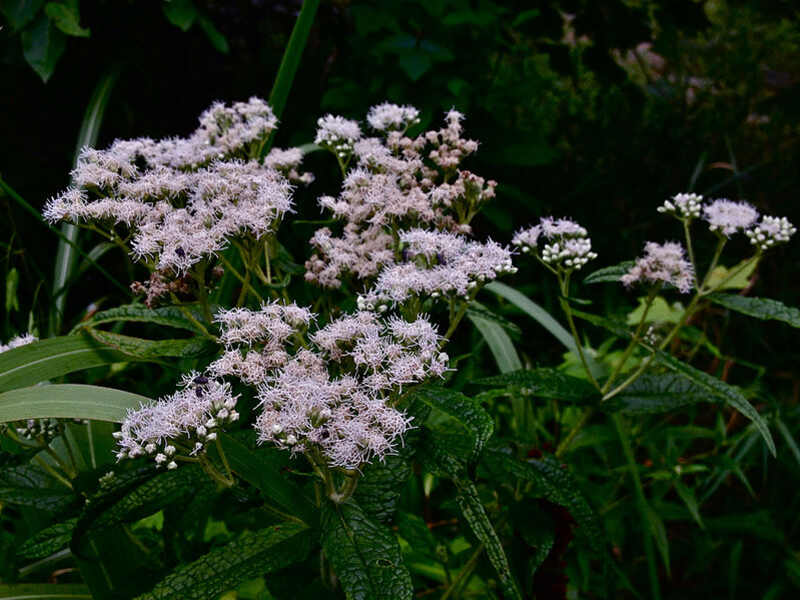
Photo Credit: Fritzflohrreynolds / Wikimedia Commons / CC BY-SA 3.0
Common boneset has been used to treat a variety of maladies, including constipation, fevers, and colds. Little white flowers appear in late summer and fall. Common boneset gives nectar to pollinators and butterflies and also attracts aphids, Lygus bugs, and leaf beetles.
This flower is serious about its water consumption and grows best when the soil does not dry out. If you have a pond on your property, common boneset is a great addition. It works well next to ponds and in rain gardens.
Although common boneset has been used medicinally, it is considered toxic and should not be consumed.
Plant type: Flower
USDA Hardiness Zone: 3 to 9
Sun: Full sun to partial shade
Soil: Organic-rich moist to wet sandy or clay soils; though it can also tolerate dry soils.
Duration: Perennial
Fragrance: Sweet, floral scent
Bloom time: Late summer to early fall
Water needs: High
Mature height: 3 to 5 feet
Potential hazards: Toxic if eaten.
Maintenance: Low
9. New England Aster (Symphyotrichum novae-angliae)
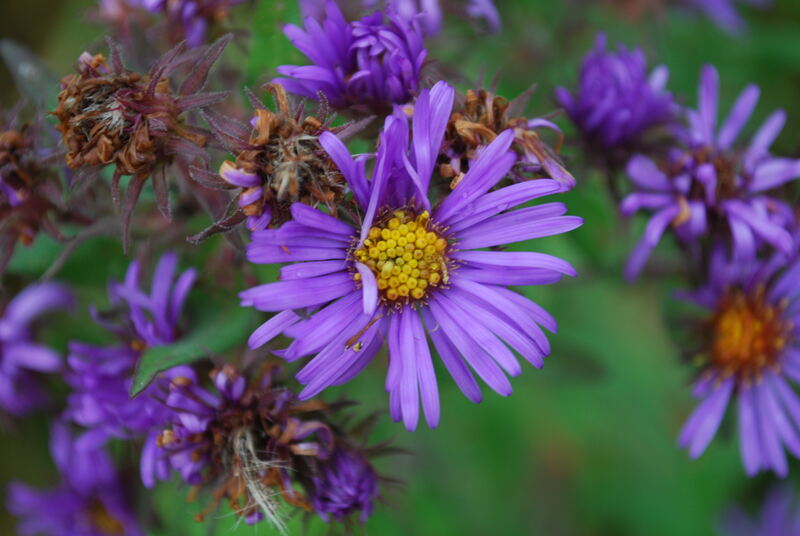
Photo Credit: Joshua Mayer / Flickr / CC BY-SA 2.0
Grand Rapids homeowners can’t help but love New England aster. Starting from late summer to late fall, it blooms for at least six weeks. It grows up to six feet tall and is still around even when Grand Rapids temperatures get cooler.
These strikingly beautiful bright pink flowers resemble daisies, but with slightly thinner petals. If your property is sometimes visited by deer or rabbits, New England aster is a great addition, as deer and rabbits prefer tastier treats. Butterflies and birds are quite pleased about this; there’s more New England aster for them to consume.
This plant needs space for good airflow or it may develop diseases. It works well in cottage gardens and borders, just as long as it’s not crowded.
Plant type: Flower
USDA Hardiness Zone: 4 to 8
Sun: Full sun to partial shade
Soil: Clay, sandy, loamy
Duration: Perennial
Bloom time: Late summer – early fall
Water needs: Medium
Mature height: 3 to 6 feet
Maintenance: Medium. If it grows tall, it may require staking or other support. Pinching back stems before midsummer controls plant height and promotes flower growth.
How to Choose Native Plants for Your Grand Rapids Yard
Choose plants that are in your area’s hardiness zones. Grand Rapids temperatures can drop into the teens or lower. Plants in the Grand Rapids zone, which are zones 5 and 6, can withstand the lowest temperatures the area may experience.
Make sure you have the yard space and capacity to grow the vegetation. Although you may have seen a few white oaks (quercus alba), the tree is huge and may not be right for a typical front yard or backyard.
In addition to knowing how much space you have, be familiar with your soil type, if your soil tends to retain water or dry out, and how sunny or shady your yard is. Select native plants that will thrive best in your yard’s composition.
Native plants are low-maintenance, but they still require some work. Gardening can be relaxing and therapeutic. However, if you feel forced to tend to your plants, it may cause undue stress. So, it’s also important to choose plants that fit your maintenance availability.
FAQ About Native Grand Rapids Plants
Grand Rapids experiences freezing winters and can have hot summers. It’s best to plant in the spring or fall. The weather is cooler and there’s more rain. This allows for roots to establish before the summer heat or before winter freezing temperatures cause dormancy.
The USDA separates the United States into different zones, with each zone representing a 10 degrees Fahrenheit difference in yearly average lowest winter temperatures.
Grand Rapids is in zones 5 and 6. Zones 5 through 6 include zones 5a, 5b, 6a, and 6b. They have temperatures that range from -20 to -15 degrees Fahrenheit for zone 5a, to -5 to 0 degrees Fahrenheit for zone 6b.
Most plants native to Grand Rapids thrive best in soil with a range of 5.5 to 7.0 pH. Some plants may tolerate soil more acidic or alkaline, and the type of plant determines where it fits in the pH soil range. It’s best to research the plant to know what type of soil is best. Without appropriate soil conditions, plants can suffer and even die.
Where to Find Native Plants in Grand Rapids
You’ve probably admired plenty of native plants while visiting the John Ball Zoo or Millenium Park. Lovely examples of Michigan native plants are likely displayed throughout your neighborhood. The Land Conservancy of West Michigan has information on local native plant sales by the Kent Conservation District and other organizations.
Another place to look if you want to bring a piece of Grand Rapids home with you is a native plant nursery. Try these local options:
You’ve already done the work of helping sustain the ecosystem by giving natural resources to butterflies, other pollinators, and local wildlife with your native landscape. Now, make sure both you and the local wildlife have a healthy turfgrass canvas, too. Let a local lawn care pro handle your lawn care needs.
Main Image Credit: Farmartin / Wikimedia Commons / CC BY-SA 4.0